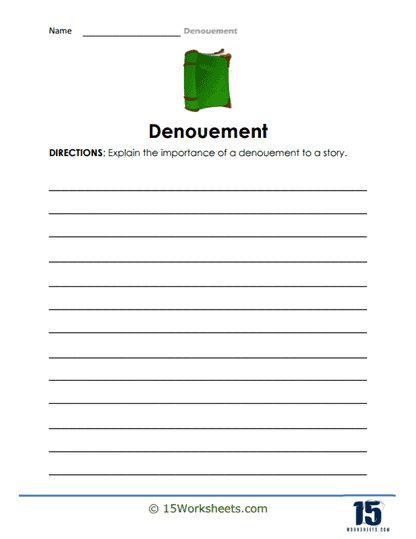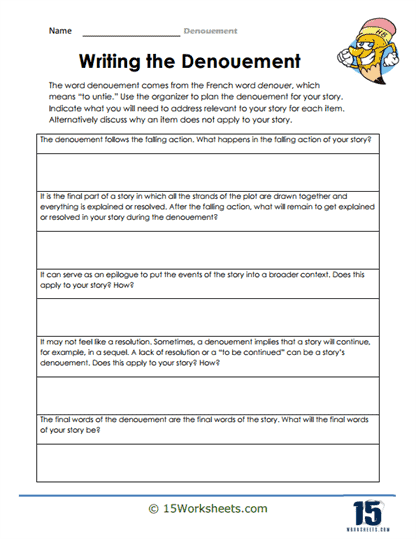Denoument Worksheets
About These 15 Worksheets
Denouement, a critical component of narrative structure, refers to the final part of a story where the plot threads are tied up, conflicts are resolved, and the outcome of the story is revealed. These worksheets were developed to enhance students’ comprehension and analysis of this narrative element. By engaging with various exercises focused on denouement, students can deepen their understanding of narrative structure, enhance their analytical skills, and improve their ability to craft coherent narratives in their own writing.
Through a variety of exercises, these worksheets not only improve students’ analytical reading and creative writing skills but also deepen their appreciation for the art of storytelling. By dissecting how stories are concluded, students develop a nuanced understanding of narrative coherence, character development, and thematic depth, equipping them with the skills necessary for both literary analysis and narrative creation. Engaging with denouement worksheets prepares students for more advanced studies in literature and enhances their overall communication skills, making them more proficient readers, writers, and critical thinkers.
Types of Exercises
Denouement worksheets include a range of exercises tailored to dissect and understand the denouement phase of a story. These exercises aim to improve students’ narrative analysis skills and their ability to identify and create satisfying story resolutions.
Identifying Denouement – Exercises that ask students to read a selection of narrative endings and identify the denouement. This practice helps students recognize how authors resolve conflicts and tie up loose ends, enhancing their analytical reading skills.
Comparing and Contrasting Denouements – These exercises involve analyzing denouements from different stories, comparing how various narratives resolve their conflicts and what effects these resolutions have on the reader. This comparison deepens students’ understanding of narrative structure and the diversity of storytelling techniques.
Creating Alternate Denouements – Students are given a story without its ending and are tasked with writing their own denouement. This exercise encourages creativity and critical thinking, as students must consider the story’s themes, character arcs, and unresolved conflicts to craft a coherent and satisfying conclusion.
Denouement and Theme Analysis – Exercises that focus on analyzing the relationship between the denouement and the story’s themes. Students explore how the resolution of the plot reinforces or illuminates the narrative’s central themes, enhancing their ability to interpret and appreciate literary themes.
Character Resolution Mapping – These exercises ask students to map out how each major character’s arc is resolved in the denouement. This practice improves students’ understanding of character development and the importance of aligning character resolutions with the story’s overall conclusion.
Plot Twist and Denouement – Some worksheets focus on stories with plot twists leading to the denouement. Students analyze how the twist affects the story’s resolution and the reader’s experience, fostering an appreciation for narrative complexity and the crafting of surprises.
Evaluating Satisfaction – Exercises where students evaluate the satisfaction level of a story’s denouement. They consider whether the resolution feels earned, logical, and fulfilling, teaching them to critique narrative effectiveness and reader satisfaction.
The Benefits of These Worksheets
Practicing with denouement worksheets offers significant benefits to students’ language arts and reading skills, emphasizing narrative analysis, critical thinking, and creative writing.
Enhanced Narrative Understanding – By focusing on how stories are concluded, students gain a deeper understanding of narrative structure. They learn that a well-crafted denouement is crucial for a story’s coherence and emotional impact, enhancing their ability to analyze and appreciate literature.
Improved Analytical Skills – Analyzing and comparing denouements sharpens students’ analytical skills. They become adept at discerning how different narrative elements-such as plot, character, and theme-are woven together to create a satisfying conclusion.
Creative Writing Development – Writing alternate denouements encourages students to engage creatively with the text, applying their understanding of narrative structure to invent new endings. This practice not only bolsters their creative writing skills but also deepens their comprehension of the story’s elements.
Thematic Insight – By examining how denouements illuminate or reinforce a story’s themes, students enhance their ability to interpret literary themes. This understanding is crucial for deep reading and for writing essays that explore thematic elements in literature.
Character Analysis – Mapping character resolutions in the denouement reinforces students’ understanding of character development. They learn to appreciate how characters’ journeys contribute to the story’s resolution and its thematic messages.
Appreciation for Complexity and Craft – Analyzing plot twists and their impact on the denouement fosters an appreciation for narrative complexity and the craft of storytelling. Students learn to value the skill involved in surprising the reader while delivering a coherent and satisfying conclusion.
Critical Evaluation Skills – Evaluating the satisfaction level of a denouement enhances students’ critical evaluation skills. They learn to assess narrative effectiveness from both a structural and an emotional perspective, considering the reader’s experience and the story’s logical coherence.
What is the Literary Device of Denoument?
Denouement, a fundamental literary device, originates from the French word “dénouer,” meaning to untie. It represents the final part of a narrative, where the plot threads are untangled, and the story concludes, resolving conflicts and answering the reader’s lingering questions. This section follows the climax of the story, offering closure to both characters and readers alike. The denouement is crucial for providing a satisfying conclusion to the narrative arc, tying up loose ends and elucidating the outcome of the story’s conflicts and complexities.
Main Defining Feature of Denouement
The core attribute of denouement is its role in resolving the story’s conflicts and mysteries, providing a clear conclusion to the narrative journey. It unravels the complexities of the plot, ensuring that each significant storyline reaches a logical and often illuminating end. Unlike the climax, which is the peak of the story’s tension, the denouement is characterized by a decrease in intensity, guiding the narrative towards a stable conclusion.
Characteristics of Denouement
Resolution of Conflict – The primary function of denouement is to resolve the main conflict faced by the characters, offering a conclusion to the central narrative tension.
Clarification of Character Fate – Denouement reveals the fate of the characters, explaining where they end up after the story’s climax and how their journeys have transformed them.
Answering Remaining Questions – Any lingering questions or mysteries left unresolved during the climax are typically addressed during the denouement, providing clarity and satisfaction to the reader.
Setting the Stage for Future – In series or sequels, the denouement might also set the stage for future stories, introducing elements that hint at what’s to come.
Emotional Resolution – Beyond the logical resolution of plot, denouement often provides an emotional resolution for the characters and the readers, delivering a sense of closure.
Examples of Denouement in Literature
Through examples from Fitzgerald, Rowling, and Austen, we see how denouements can vary in their execution but consistently serve to resolve conflicts, answer questions, and provide emotional and thematic closure. The effective use of denouement not only enhances the reader’s experience by offering a sense of completion but also deepens their engagement with the narrative’s broader implications and themes.
Example 1 – “The Great Gatsby” by F. Scott Fitzgerald
The denouement of “The Great Gatsby” occurs after the dramatic climax involving the tragic deaths of Gatsby and Myrtle. In the concluding chapter, Nick Carraway reflects on the events that unfolded, organizes Gatsby’s funeral, and decides to move back to the Midwest, disillusioned with the East Coast’s moral decay. Fitzgerald uses the denouement to underscore the themes of the American Dream and the moral vacuity of the Jazz Age, providing a somber resolution to the narrative and the characters’ arcs.
Example 2 – “Harry Potter and the Deathly Hallows” by J.K. Rowling
The denouement of the final book in the Harry Potter series occurs after the defeat of Voldemort. Rowling provides a detailed epilogue that takes place 19 years later, showing the main characters as adults who have moved past the trauma of their youth. This denouement serves to assure readers that the characters have found happiness and peace, fulfilling the emotional and narrative closure needed after such an epic saga. It addresses the fate of the surviving characters, answers lingering questions about the wizarding world’s future, and solidifies the story’s underlying themes of love, sacrifice, and resilience.
Example 3 – “Pride and Prejudice” by Jane Austen
Austen’s denouement unfolds after the climax of Elizabeth Bennet and Mr. Darcy’s mutual confessions of love and their engagement. In the concluding chapters, Austen resolves the remaining subplots, including Lydia’s scandalous marriage to Wickham and the unions of Jane Bennet to Mr. Bingley, and Charlotte Lucas to Mr. Collins. This denouement not only ties up the loose ends but also reaffirms the novel’s critiques of marriage, class, and social expectations, offering a satisfying conclusion that rewards the virtues of its protagonists while providing a critique of its society.
Effect of Denouement on the Reader
The denouement has a profound impact on the reader’s experience and satisfaction with a story. It offers a sense of closure, ensuring that the emotional and narrative investment in the characters and plot comes to a fulfilling conclusion. This resolution allows readers to reflect on the journey and its implications, both within the story’s universe and in their interpretations of its themes and morals.
Emotional Satisfaction – By resolving the characters’ journeys and conflicts, the denouement provides emotional satisfaction, allowing readers to feel that the narrative journey was worthwhile.
Intellectual Closure – Answering lingering questions and tying up loose plot threads, the denouement offers intellectual closure, rewarding attentive reading and encouraging deeper reflection on the story’s themes and messages.
Thematic Resolution – The denouement often emphasizes and clarifies the story’s themes, allowing readers to fully grasp the narrative’s moral or message, enriching their understanding of the text.















